
The Political Economy of East German Privatization
(Hardback)
Publishing Details
The Political Economy of East German Privatization
By (Author) Phyllis Dininio
Bloomsbury Publishing PLC
Praeger Publishers Inc
30th June 1999
United States
Classifications
Tertiary Education
Non Fiction
Political economy
338.92509431
Physical Properties
Hardback
152
Description
This text examines patterns of industrial assistance in the German Lander (federal state) during the difficult transition from central planning to a market economy. The author identifies the restructuring assistance given by the privatization agency, the Treuhandanstalt and the federal state governments as the chief instruments of eastern industrial policy. In seeking to explain how the aid was allocated the interests and policy resources of state and societal actors are examined. The analysis shows that institutions conditions to a significant extent the societal forces to which state actors respond in their policy choices. In the case of East Germany, the interplay of institutions and circumstances led to a large-firm bias. The unitary business and labour organizations that were extended into the East could not accommodate the divergent interests of members and so failed to lobby on their behalf for industrial assistance. While societal actors remained relatively passive, state actors intervened on behalf of select firms. The primacy of certain state actors but not others in these interventions as well as their primary policy agendas, derived from the institutional contours of the German polity. First, the constitution of a federal agency to privatize 13,000 firms singly and under severe time pressure prompted agency officials to give priority to large firms in the interest of expediency. Second, the dominance of the executive branch, enabled Chancellor Kohl to help his supporters in the chemical industry and at Carl Zeiss Jena as well as troubled firms of national significance, such as the shipyards and the giant steel milk EKO-Stahl. Third, the federal structure of the government gave Lander officials significant resources to support big employers in their state, especially those from regionally dominant industries.
Reviews
.,."very well referenced and provides a fascinating view of how intervention in the east was relatively ad hoc, politically driven and without a wider, regionally integrated strategy."-German Politics
...very well referenced and provides a fascinating view of how intervention in the east was relatively ad hoc, politically driven and without a wider, regionally integrated strategy.-German Politics
..."very well referenced and provides a fascinating view of how intervention in the east was relatively ad hoc, politically driven and without a wider, regionally integrated strategy."-German Politics
Author Bio
PHYLLIS DININIO is with the Center for Democracy and Governance at USAID, where she provides guidance on anti-corruption strategies for developing and transitional economies. Dr. Dininio has provided technical assistance to governments in Romania, Bulgaria, Ukraine, and states in Africa, Asia, and Latin America. She recently completed a USAID Handbook on Fighting Corruption (1998).
